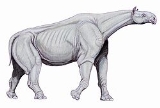
Paraceratherium
Overview
Paraceratherium, also commonly known as Indricotherium or Baluchitherium (see taxonomic discussion below), is an extinct
genus
of gigantic hornless rhinoceros
-like mammals of the family Hyracodontidae
, endemic to Eurasia and Asia during the Eocene
to Oligocene
37.2—23.030 Mya, existing for approximately . It was first discovered in the Baluchistan province of Pakistan
, hence the name, by Sir Clive Forster Cooper.
Paraceratherium is the largest land mammal known, larger than the largest species of mammoth
s (Mammuthus sungari
, which may have approached it in size and weight).
Extinction
In biology and ecology, extinction is the end of an organism or of a group of organisms , normally a species. The moment of extinction is generally considered to be the death of the last individual of the species, although the capacity to breed and recover may have been lost before this point...
genus
Genus
In biology, a genus is a low-level taxonomic rank used in the biological classification of living and fossil organisms, which is an example of definition by genus and differentia...
of gigantic hornless rhinoceros
Rhinoceros
Rhinoceros , also known as rhino, is a group of five extant species of odd-toed ungulates in the family Rhinocerotidae. Two of these species are native to Africa and three to southern Asia....
-like mammals of the family Hyracodontidae
Hyracodontidae
Hyracodontidae is an extinct family of rhinoceroses endemic to North America, Europe, and Asia during the Eocene through early Miocene living from 55.8—20 mya, existing for approximately .They are typified as having long limbs and having no horns...
, endemic to Eurasia and Asia during the Eocene
Eocene
The Eocene Epoch, lasting from about 56 to 34 million years ago , is a major division of the geologic timescale and the second epoch of the Paleogene Period in the Cenozoic Era. The Eocene spans the time from the end of the Palaeocene Epoch to the beginning of the Oligocene Epoch. The start of the...
to Oligocene
Oligocene
The Oligocene is a geologic epoch of the Paleogene Period and extends from about 34 million to 23 million years before the present . As with other older geologic periods, the rock beds that define the period are well identified but the exact dates of the start and end of the period are slightly...
37.2—23.030 Mya, existing for approximately . It was first discovered in the Baluchistan province of Pakistan
Pakistan
Pakistan , officially the Islamic Republic of Pakistan is a sovereign state in South Asia. It has a coastline along the Arabian Sea and the Gulf of Oman in the south and is bordered by Afghanistan and Iran in the west, India in the east and China in the far northeast. In the north, Tajikistan...
, hence the name, by Sir Clive Forster Cooper.
Paraceratherium is the largest land mammal known, larger than the largest species of mammoth
Mammoth
A mammoth is any species of the extinct genus Mammuthus. These proboscideans are members of Elephantidae, the family of elephants and mammoths, and close relatives of modern elephants. They were often equipped with long curved tusks and, in northern species, a covering of long hair...
s (Mammuthus sungari
Mammuthus sungari
Mammuthus sungari, sometimes called the Songhua River Mammoth, evolved from smaller Siberian mammoths and occurred in Northern China during the middle Pleistocene...
, which may have approached it in size and weight).
Unanswered Questions
Discussions

